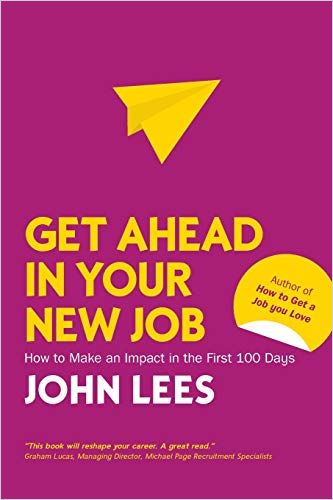Career management consultant John Lees provides a detailed blueprint for your first 100 days in a new job. Those in their first job should heed his advice even longer than that.

Your New Job
Career management consultant John Lees explains how and why you must hit the ground running, make a good first impression and deliver quickly at your new job. He shows you how to make the most of your transition into a new position by being strategic about how you show up during your first 100 days. Lees covers deciding whether to take a job, enhancing your career, building your reputation, understanding your new organization, cultivating relationships, dealing with obstacles, avoiding traps, continuing to grow and – eventually – identifying when it’s time to move on.
Reputation and Opportunities
When you start to pursue a prospective job, investigate it thoroughly. Try to learn why the opening exists and what you’d be expected to do. During your interview, consider salary, benefits and how the organization’s culture and the job fit your career goals.
Lees sees job offers as a negotiable opportunity to ask for up to three changes, such as requesting more meaningful responsibilities. If the position is new, clarify why and how the organization created it and whether you’d have authority and support.
The first 100 days of any new job shape your reputation and prospects. Gather information, develop relationships and seize opportunities.
Look ahead at the way the job is likely to develop, opportunities for learning and the chances of progression.John Lees
Make your new boss and associates glad their company hired you. Switch into learning mode and out of the self-promoting attitude you had to assume to land the job.
Project how your new job will be going in a year and a half – and in five to 10 years. Always be strategic about what you work on, Lees advises. Be aware of how you work and how you shape your career. Stay alert to trends that might make you want to move on or shift your emphasis.
Research the organizational chart and learn the local jargon. Show respect for existing work, employees and methods. Build trust by asking questions about the firm and heeding your colleagues’ work styles. Notice who does their job well, creates change and advances.
Connect with your coworkers. Identify people who could share information or facilitate your work. To understand the firm’s expectations, barriers and opportunities, research your predecessor’s circumstances and why the company chose you to fill his or her position.
Lees cautions you to be aware that many organizations have two cultures – an outward-facing culture and a real-world, day-to-day culture. Talk to others to understand the organization’s true character. What are the people like? What is their frame of mind, work style and value system? Who makes decisions – and how?
Consider your job in the context of its past, present and future. Analyze how your work meshes with other people’s goals? Determine how your boss and peers will measure your performance. Find out what the firm does best, its challenges, its reputation and how you might change that for the better. Be alert to opportunities and boundaries.
Even as you’re learning your way around, Lees warns, you must produce results. Show that you catch on quickly. Deliver fast on the promises you made in your job interview. Prioritize work that aligns with the organization’s goals. Make sure your work is “OBVIOUS: Observable, Benchmarked, Visible, Individual, On target, Understood and Special.” Respect and align yourself with the company’s culture.
Identify your objectives, which should be quantifiable, feasible, related to your employer’s goals and motivating. Creating satisfaction is at least as important as meeting goals.
Strategic Development
As you settle into your new job, consciously build relationships with those who can advise and advocate for you. Connect with everyone on your new team. Avoid talking about the way you worked in the past.
Learn your bosses’ communication preferences. Do what makes them happy and adds to their standing. Lees suggests spending 20 minutes each week writing a summary of your accomplishments that your higher-ups can review in two minutes. Focus on what the organization and your colleagues need, not on what you have to offer.
Your first two weeks in the job may have far more impact on your image and prospects than any other fortnight you spend in the role.John Lees
If you’re feeling pressured, pinpoint the cause and find creative ways to cope. Try to resolve that pressure without involving your boss or needing more resources. Strategically avoid saying yes to requests so that you forestall people overwhelming you with tasks.
Organizational politics may crop up in the form of competition, backbiting or other destructive behaviors. Lees directs you to take the high ground by staying honest, kind, trustworthy, positive and gracious. If unprofessional competitive behaviors are part of the culture, consider leaving the organization.
Identify and deal with your coworkers’ ego issues. Thoughtfully manage the employees who report to you but who may be older, more experienced or more seasoned than you. Welcome their wise input while remaining in charge.
Thrive
Present yourself as a reliable, prompt team player who is innovative and respectful of the status quo. The best way to attract positive attention, Lees confirms, is by doing excellent work.
Seek opportunities to contribute. Show interest in advancing. Find a mentor or colleague who can help you decode the culture.
As part of your strategic approach to your first 100 days, Lees says, remain alert to situations that might lead to failure, such as insufficient resources for a task or managerial preconceptions that constrain your assignments. Turn down promotions that don’t serve you, work around systemic limits to growth, maintain diverse skills and stay willing to make mistakes. Never badmouth others, act crabby or show up looking unkempt. Be indispensable and quietly make sure people are aware of your contributions.
If your boss doesn’t offer a review, ask for one at six months. If the outcome of your review is unsatisfying, make the changes that seem necessary and propose another review in six months or less. Twice a year, go over what you’ve learned, how you contributed and how you advanced your career. Consider how your job aligns with your expectations and skills. Identify your priorities – money, independence, mission and cultural alignment.
Whether you stay or move, do so for the right reasons.John Lees
After your first year, discuss your career development with your boss, make suggestions for career-enhancing change or consider where you want to go next. Whether you stay or go, always grow.
First Job
Though John Lees presents his book as a primer for someone’s first 100 days in a new job, it’s really a sound, detailed, practical guide to your first job. If you survived in the job market long enough to apply for a new position, you probably already know or have figured out everything Lees suggests. But, if you are fresh out of school or new to the job market and have applied for and gotten your first serious job, Lees’ advice will prove indispensable. He is neither sentimental nor Machiavellian. He proposes that you follow a mainly straightforward strategy that prioritizes your ambitions, passions and survival while still insisting that the only way for you to succeed is to excel. Lees prefers simple, readable sentences and good for him. Read everything he says before you apply for your first job and every time you make a change.





